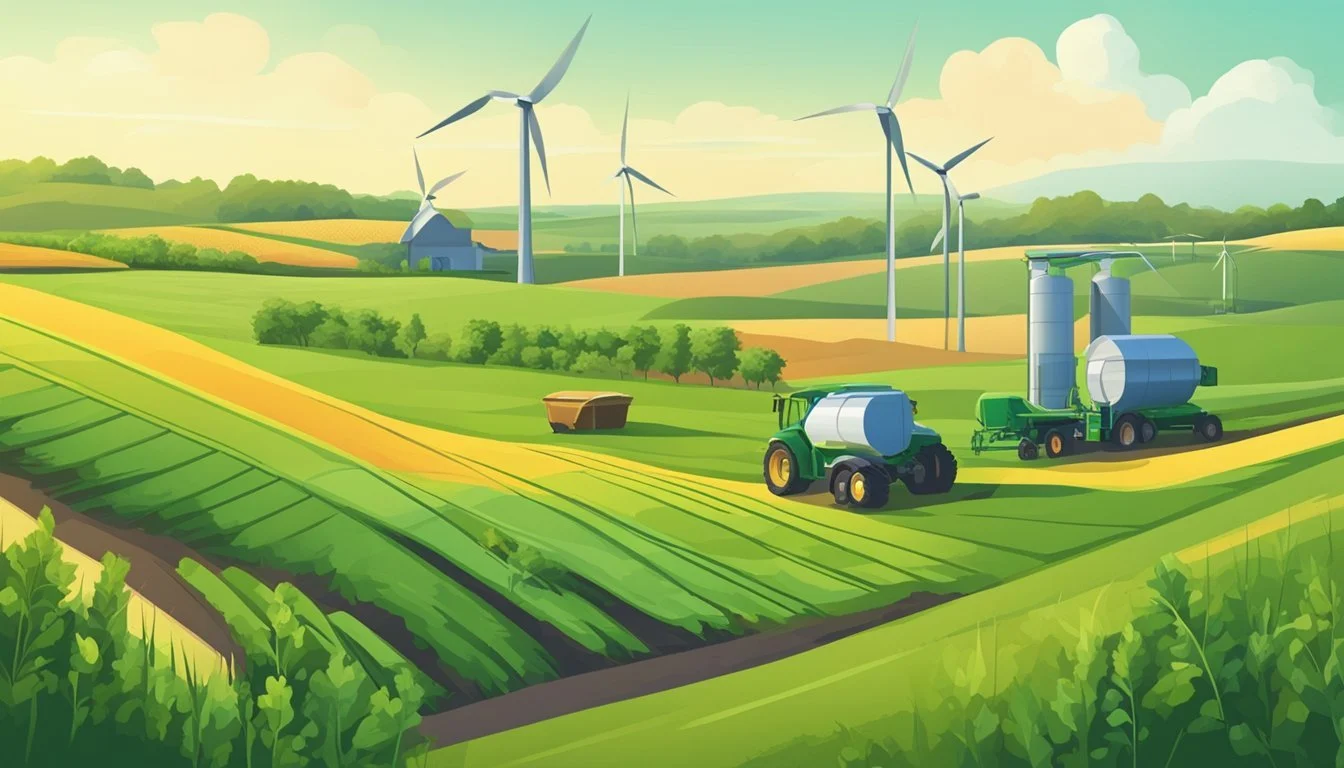Farming Communities in Ohio
A Closer Look at Agriculture Trends
Farming communities in Ohio offer a unique glimpse into a way of life that is closely connected to the land and traditions. With a variety of charming small towns and unincorporated communities like Walnut Creek in Holmes County, visitors can experience the peaceful ambiance of rural living. These areas are nestled in the heart of Ohio Amish Country, known for their picturesque landscapes and rich agricultural heritage.
Ohio's farmland is vast and diverse, with counties featuring significant agricultural activity, driven by hardworking farmers who participate in various USDA income support programs. This dedication to farming not only sustains local economies but also preserves the scenic beauty and cultural traditions that define these communities. Exploring these regions reveals covered bridges, quaint shops, and a slower pace of life that contrasts with urban hustle and bustle.
Additionally, Ohio offers a range of farmhouses for sale, from modern estates to historic plantations, showcasing the timeless appeal of countryside living. Luxurious developments like the Farmstead near Cincinnati, a 100-acre luxury farm community, highlight the blend of traditional and contemporary rural lifestyles, making Ohio an enticing destination for those looking to get away from it all.
Overview of Ohio's Agricultural Landscape
Ohio's agricultural landscape is vast and varied, playing a crucial role in the state's economy. The state's farming communities and operations are not just significant locally but also impact the national agricultural scene.
The Importance of Agriculture in Ohio
Agriculture stands as Ohio's leading industry, shaping both the economy and the daily lives of its residents. Spanning over 13.5 million acres, Ohio's farmland supports diverse agricultural activities. This sector's significance is underscored by its contribution to food supply, job creation, and rural development.
Economic activities related to agriculture include crop production, livestock farming, and food processing. Ohio’s agricultural output supports local markets and national distribution. Through initiatives and policies, entities like the Ohio Farm Bureau focus on maintaining a favorable business climate and a responsible regulatory environment for farms.
Diversity of Farming Operations in Ohio
Ohio's farming operations are diverse, encompassing various scales and types of farming practices. From large commercial farms to smaller family-operated farms, the state's agricultural landscape reflects a rich mosaic of production techniques and products.
Crops such as corn, soybeans, and wheat dominate large sections of the farmland. Meanwhile, specialty crops and organic farming practices are increasingly gaining ground. Agricultural operations also include dairy, poultry, and beef production, contributing significantly to both the state’s economy and dietary supply.
This diversity ensures resilience against economic volatility and environmental changes, promoting sustainable farming practices across the state. Ohio's multifaceted farming operations highlight their adaptability and the vital role they play in both state and national agriculture.
Soil and Land Use
Ohio's farming communities operate within specific land use policies and practice various conservation methods to maintain soil quality. Sustainable farming practices help mitigate environmental impacts and support the preservation of farmland.
Soil Quality and Conservation Practices
Ohio's soil quality varies across regions, but common practices enhance its fertility and stability. Farmers utilize cover crops to prevent erosion, and crop rotation to maintain nutrient balance. Mulching and no-till farming help retain soil moisture and reduce compaction.
Conservation initiatives like soil testing guide the use of fertilizers and amendments, ensuring optimal growth while minimizing negative effects on land. Non-abrasive fertilizers and soil inoculants aid in promoting healthy soil ecology. These collective efforts secure the base for productive and sustainable agriculture.
Land Use Policies and Farmland Preservation
Land use policies in Ohio focus on balancing development with the need to preserve agricultural land. The Office of Farmland Preservation helps farmers by offering tools and incentives to protect their land from urban sprawl. Between 1950 and 2000, Ohio lost over 6.9 million acres of farmland, heightening the urgency for stringent policies.
Programs such as agricultural easements and land trusts play a significant role in maintaining farmland for future generations. By regulating zoning laws and providing tax incentives, these policies ensure that farming remains viable and that Ohio's rich agricultural heritage is preserved.
Sustainable Farming and the Environmental Impact
Sustainable farming practices are crucial in reducing environmental footprints. Techniques like adaptive reuse of urban land into farms help convert unused spaces into productive agricultural areas. Methods such as hydroponics and aeroponics allow for efficient use of resources in densely populated areas.
Efforts by organizations like The Nature Conservancy promote regenerative agricultural practices. These include the use of organic farming techniques, integrated pest management, and promoting biodiversity on farms. Sustainable farming not only supports high yield but also works towards an equitable and environmentally resilient food system.
By integrating these practices, Ohio's farming communities continue to thrive while safeguarding the land and soil for future generations.
Farm Economy and Business Climate
Ohio's farming communities play a critical role in the state's economy, contributing significantly through agricultural production and grassroots advocacy. Challenges such as economic volatility and regulatory pressures are met with proactive measures and plans to sustain growth and development.
Economic Development Opportunities in Agriculture
Economic opportunities in Ohio's agriculture sector are diverse. The state has over 14 million acres of farmland, supporting a $5 billion industry. Advances in agricultural technology and sustainable practices are paving the way for higher productivity and profitability. Nurturing local food systems and organic farming offers potential growth, driven by consumer demand for locally-sourced products.
Strategic initiatives focus on creating a supportive environment for farm businesses. Financial incentives, grants, and partnerships aim to foster innovation and expansion. Investment in infrastructure, such as improved irrigation systems and storage facilities, enhances efficiency and reduces costs for farmers.
Ohio Farm Bureau and Farming Advocacy
The Ohio Farm Bureau plays a pivotal role in advocating for farmers' interests. With a focus on creating a strong business climate, the Bureau engages in grassroots advocacy to influence policy decisions. It facilitates dialogue between farmers and legislators, ensuring that farming priorities are heard and addressed.
Programs and resources offered by the Bureau include training, legal support, and advocacy campaigns. These initiatives help farmers navigate challenges such as fluctuating markets and regulatory changes. By emphasizing community involvement, the Bureau strengthens the voice and impact of Ohio's agricultural sector.
Regulatory Environment Affecting Ohio Farmers
Ohio farmers operate within a complex regulatory framework. Policies related to land use, environmental protection, and food safety impact farming operations. The Ohio Farm Bureau's advocacy efforts aim to create a balanced regulatory environment that protects both agricultural interests and public health.
Regulations on water quality and pesticide use are crucial elements. Farmers must comply with standards that safeguard natural resources while maintaining productivity. Understanding and adapting to regulatory changes is essential for long-term sustainability. Collaboration between policymakers and farming communities ensures that regulations are practical and supportive of agricultural growth.
Technological Advancements and Infrastructure
Farming communities in Ohio are increasingly benefiting from technological innovations and improved infrastructure, significantly enhancing productivity and sustainability. Key areas of focus include broadband access for telehealth services, transportation infrastructure for farm products, and advanced agricultural technologies.
Broadband Access and Telehealth Services
Broadband access is crucial for Ohio's farming communities, providing essential high-speed internet for various applications. Telehealth services are becoming more accessible, enabling farmers to consult with healthcare providers without needing to leave their farms.
High-speed internet supports other vital needs such as online education, access to market information, and remote monitoring of agricultural processes. Investments in broadband infrastructure ensure these communities stay connected, enhancing overall quality of life and operational efficiency.
Transportation Infrastructure for Farm Products
Ohio's transportation infrastructure plays a critical role in moving agricultural products to market. Efficient roads, highways, and rail systems are essential for timely and cost-effective distribution.
The state has invested in upgrading rural roads and bridges, reducing transit times and costs for farmers. Reliable transportation infrastructure helps ensure that fresh produce, dairy, and livestock reach consumers quickly, maintaining quality and reducing waste.
Innovations in Agriculture Technology
Innovations in agricultural technology are transforming Ohio's farming practices. Self-driving tractors, robotic milking systems, and drones for crop monitoring are now more commonplace on farms.
These technologies improve precision, efficiency, and sustainability. For instance, drones equipped with sensors can determine crop health and application needs, while automated tractors and milking robots reduce labor demands.
Ohio State University's Farm Science Review showcases these innovations, offering farmers firsthand exposure to the latest advancements. Improved connectivity infrastructure further supports these technological applications, integrating them seamlessly into daily farm operations.
Environmental Programs and Policies
Ohio has implemented several environmental programs and policies aimed at enhancing water quality, promoting smart growth, and encouraging grassroots advocacy. These initiatives provide critical support for agricultural producers and landowners in the state.
Water Quality Initiatives like the H2Ohio Program
The H2Ohio Program is a key initiative aimed at improving water quality in Ohio. Established by the state, it focuses on reducing phosphorus runoff and preventing algal blooms in water bodies.
Landowners and farmers receive financial incentives to adopt practices such as nutrient management planning, wetland restoration, and buffer strip installation. By incorporating these measures, they help maintain cleaner waterways and a healthier ecosystem.
Smart Growth Policies and Landowner Protections
Ohio's smart growth policies are designed to balance development with environmental sustainability. These policies include zoning regulations, land preservation efforts, and incentives for sustainable land use.
One significant feature is the Environmental Quality Incentives Program (EQIP), which assists landowners in adopting conservation practices. The program helps mitigate soil erosion, protect water resources, and enhance wildlife habitat.
Grassroots Advocacy and Environmental Stewardship
Grassroots advocacy plays an essential role in environmental stewardship within Ohio's farming communities. Organizations such as the Ohio Farm Bureau focus on building strong business climates while advocating for responsible environmental practices.
Community-led initiatives emphasize preserving farming heritage and promoting sustainable agricultural techniques. Programs encourage local engagement, ensuring that the interests of farmers are represented in environmental policymaking.
Ohioans actively participate in efforts to conserve natural resources, thereby fostering a collaborative environment for sustainable farming. By prioritizing both agricultural productivity and ecological health, these policies serve the dual purpose of supporting farmers and protecting natural resources.
Agricultural Communities and Rural Development
Agricultural communities in Ohio are vital to the state's economy and cultural heritage. These communities face various challenges but also have numerous opportunities for growth and development.
Rural Community Services and Healthcare
Access to essential services and healthcare remains a critical need. Rural Development programs have been pivotal in bringing grants and loans to enhance community facilities. Healthcare services, including hospitals and clinics, are often far from these communities, creating significant challenges.
Efforts to increase telemedicine and mobile clinics are ongoing. Community Facilities Direct Loan & Grant Program has invested in clean energy projects, showing a commitment to infrastructure that supports both health and economic growth.
Challenges and Opportunities for Farming Communities
Economic volatility is a significant challenge for Ohio's farming communities. The agriculture sector faces price uncertainties and supply chain issues, exacerbated by regulatory changes and climate impacts.
Opportunities present themselves in the form of technology adoption and sustainable farming practices. The 2024 Action Plan emphasizes creating a strong business climate and preserving farming heritage. Grassroots advocacy and a responsible regulatory environment can mitigate some challenges.
Leadership and Labor Resources in Farming
Effective leadership and sufficient labor resources are crucial. Ohio farms require skilled labor, which is often in shortage. Programs focusing on agricultural education and training are essential for providing a capable workforce.
Leadership from the Ohio Farm Bureau and other local organizations plays a significant role in policy advocacy and community support. These groups help maintain a thriving agricultural community by fostering strong leadership and labor resource management.
Ohio's Farming Heritage and Cultural Significance
Ohio's farming history has played a crucial role in shaping its communities and economy. Agricultural practices in Ohio have evolved over time to include various crops and techniques and have impacted the state's social fabric.
Historical Perspective on Farming in Ohio
Farming in Ohio began in earnest when it became a state in 1803. Early settlers focused on crops like wheat, corn, barley, oats, and rye. Throughout the 19th century, these staple crops drove Ohio's agricultural economy.
The Ohio Department of Agriculture's Historic Family Farms program highlights the long-standing agricultural heritage. This program honors families with farms that have been continuously operational for over 100 years, showing the deep-rooted significance of farming.
The transition from manual farming methods to mechanized equipment revolutionized Ohio's farming practices. Technological advancements allowed Ohio farmers to increase productivity and sustain the agricultural industry through changing times.
Cultural and Educational Aspects of Farming
Farming in Ohio goes beyond economic contributions; it is embedded in the state's culture and education. Programs such as those run by the Ohio Ecological Food and Farm Association (OEFFA) provide education on sustainable farming practices. These educational initiatives support both farmers and the public in embracing local and organic food systems.
Cultural events like county fairs and farmers' markets are mainstays in Ohio communities, celebrating the agricultural lifestyle and fostering communal bonds. These gatherings often feature agricultural exhibits, competitions, and educational workshops, reinforcing farming's cultural importance.
Furthermore, Ohio's agricultural heritage is preserved and promoted through various public and private initiatives, ensuring that the history and practices of farming remain an integral part of Ohio's community identity.
Current Trends and Future Directions
Ohio's farming communities are evolving with key trends in agriculturally sourced biofuels and energy, value-added products in emerging markets, and youth engagement through various programs.
Agriculturally Sourced Biofuels and Energy
Ohio's agricultural sector is increasingly focused on biofuels as a sustainable alternative to traditional energy sources. Farmers are adopting the cultivation of energy crops such as soybeans and corn to produce biodiesel and ethanol. This shift not only supports energy independence but also provides additional revenue streams. Some farms are also investing in on-site biogas production from livestock manure. This dual approach helps reduce waste while generating renewable energy, highlighting the innovative spirit of Ohio's agricultural community.
Emerging Markets and Value-Added Products
Emerging markets are crucial for enhancing farm profitability. Ohio farmers are diversifying their product lines to include value-added goods like artisanal cheeses, specialty crops, and organic produce. These products cater to niche markets and contribute to higher profit margins. There is also a growing trend towards direct-to-consumer sales through farmers' markets, CSAs (Community Supported Agriculture), and online platforms. This direct engagement with consumers ensures better price control and fosters a strong community connection, making local produce more accessible.
Youth Engagement through Programs like Young Ag Professionals
The future of Ohio's agriculture relies on youth engagement initiatives. Programs like Young Ag Professionals play a significant role by providing networking opportunities, education, and resources to young farmers. These programs aim to attract the younger generation to agriculture, ensuring the continuity of farming traditions. Workshops, leadership training, and mentorship are pivotal components, empowering young individuals to take on significant roles within the agricultural sector. As a result, a new wave of energized, informed, and innovative young farmers is emerging, ready to drive forward the farming community in Ohio.








